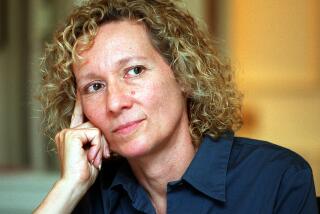Corita Kent’s distinct pop of art-activism on view at a Pasadena show
Corita Kent. You know the name, or you don’t. She’s celebrated as one of the most popular Los Angeles artists of the last century, or she remains an unsung hero with legions who have yet to discover her work.
This, despite the fact that the prolific artist and erstwhile nun could produce more than 50 of her sought-after Pop art prints in a couple of weeks. From 1938 to 1968, Kent lived and worked at the Immaculate Heart College, the campus on Western Avenue that now houses the American Film Institute. Under her leadership, the art department at Immaculate Heart became a hotbed of the counterculture.
Kent’s lectures were often proceeded by films, including those by Francois Truffaut. Field trips were taken to the office of Midcentury designers Ray and Charles Eames, and the annual art fair was an “it” avant-garde happening, attracting Kent admirers, including Alfred Hitchcock, Buckminster Fuller and John Cage. Kent’s prestige and activism even landed her on the cover of Newsweek in 1967 under the headline “The Nun: Going Modern.”
Kent’s art, which consisted largely of screen prints with bold stylized letters and slogans, was of and for the people. Direct, unflinching and inspired by the slick detritus of pop culture, it invigorated her followers, inspiring them to action in the messy war-time morass of the 1960s. With the country once again engaged in a lengthy, controversial overseas war, her work, with its emphasis on peace and understanding, resonates with fresh power. This is why curators Ian Berry and Michael Duncan thought it time to stage the first full-scale exhibition on the arc of Kent’s career: “Someday Is Now: The Art of Corita Kent,” opening Sunday at the Pasadena Museum of California Art.
“She’s a new discovery and a legend at the same time,” Berry says.
One of Kent’s most famous works was the 1985 “Love” design she made for the U.S. Postal Service, which issued more than 700 million of the simple stamps. Another was a piece that took the imagery of a Wonder Bread wrapper and turned it into a commentary on hunger and poverty.
“She extrapolates Wonder Bread polka dots and transforms them into Eucharist wafers,” Duncan says. “She’s getting back to what bread really means, and what she’s celebrating is wonder.”
Kent left Immaculate Heart and moved to Boston to make art full time. She was an insomniac who read prolifically — poetry, philosophy, literature, even Look magazine, from which she divined inspiration for her work. In 1966, when she staged more than 150 solo shows in galleries, museums and universities around the country, The Times named her “Woman of the Year.”
Despite all of this, she remains in the shadows of art history. Not even Ray Smith, director of the Corita Art Center, the Los Feliz organization dedicated to preserving and promoting her legacy, was particularly familiar with Kent when she took the job.
“It was amazing to me that nobody taught her to me in my university art program,” says Smith, who was hired based on her background in arts administration.
LACMA has eight Kent pieces in its collection (and sells a Sister Corita Kent Wonderbread Mug for $12 in its gift shop).
“She’s a very neglected figure,” Duncan says. “She’s left out of a lot of discussions.”
Kent went to the Market Basket grocery store and found signage, logos, products, phrases, typefaces and colors in the same way that other artists like Ed Ruscha and Andy Warhol did, Berry says. Warhol and Kent were both hard-working Catholic print makers, Duncan notes, adding that in 1962, Kent went to see the first West Coast solo show of Warhol’s work at the famed Ferus Gallery on La Cienega Boulevard in L.A. When she left, she remarked that she started seeing everything through Warhol’s eyes.
Although her profound fascination with art is paramount to understanding her as a person, one of the most striking aspects of Kent’s legacy was her devotion to teaching at the college.
“I was so enthralled with the place,” recalls former student Baylis Glascock, who made films of Kent. “They had a Wurlitzer jukebox that had 200 LPs. They had everything from Dylan Thomas to Bob Dylan. They were just attuned to everything.”
As a teacher, Kent was demanding and exacting, say Glascock and others, including former student Jan Steward, a graphic artist with whom Kent co-wrote the book “Learning by Heart: Teachings to Free the Creative Spirit.”
“Most of the students absolutely worshiped her. People wanted to be her best friend,” Steward says. “On my first day we were supposed to draw 3 inches of our arm for the first three hours. It took me so long to figure it out, I was so upset.”
Steward adds that the devotion Kent inspired wasn’t because she was warm and kind, because as much as she was, she wasn’t always. She was a perfectionist who expected the same level of professionalism from her students as she did from herself.
The purpose of Kent’s epic art exercises, Glascock says, was to give students assignments so massive that they would stop thinking and just do it.
“The goal was to teach you to open your eyes and see things you had not thought of before,” he says.
Corita Art Center’s Smith says another assignment was to draw 200 Coke bottles overnight and present them to Kent the following day.
The Corita Art Center lent about 150 of the 200 pieces of art and ephemera in the Pasadena exhibit, including posters, signature serigraphs and text pieces as well as rarely displayed photographs of Kent at work.
“L.A. has such a short memory, and there is this idea that the current pop art scene just happened out of nowhere, but Shepard Fairey didn’t just pop up in L.A. for no reason,” Smith says of Kent’s influence on generations of artists. “Silk-screened posters were the same idea as Twitter before Twitter existed. There had to be a message that was bold and short and easily reproduced in order to mobilize people.”
Kent was very much the activist, co-curator Duncan says.
“When you know something about her, you know goodness is what she’s promoting,” he says. “She took Madison Avenue appeal and twisted it around to make it positive. She found the humanity behind the statements we use every day.”
Kent’s liberal leanings, including her participation in protest marches and her passion for civil rights, ultimately put her at odds with the L.A. Archdiocese, which spurred her exit from the college in the late ‘60s. She died of cancer at home in Boston in 1986.
“She had a hard time in the community,” Steward says. “I wanted to adopt her and cook for her and she was, of course, perfectly independent.”
More to Read
The biggest entertainment stories
Get our big stories about Hollywood, film, television, music, arts, culture and more right in your inbox as soon as they publish.
You may occasionally receive promotional content from the Los Angeles Times.







